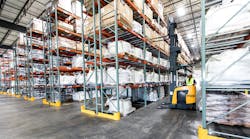For both small and large transit companies, maintaining multiple locations or expanding into new markets involves lots of variables. Exploring costs and service-bundling options could mean greater efficiencies and money saved—and a better chance of success.
One of a company's first considerations should be its risk tolerance and customers' expectations before jumping in prematurely, suggests Frank Granieri, chief operating officer at A. Duie Pyle.
Expanding its national offerings, the transportation, logistics and warehousing services provider is now offering bundled services, with an emphasis on warehousing and technology.
"We see many organizations interested in focusing on their core competency to grow their business," Granieri says. "Transportation and distribution can become a distraction that consumes valuable time and energy," he notes, just like driver recruiting and retention, industry regulations, and ever-changing technology.
All of these business components have costs associated with them, so rapid growth in an expanded transportation and distribution effort may help reach a tipping point, Granieri explains. There could be much to gain if a single provider offers a discounted rate for managing several aspects of the fleet enterprise.
In other words, delegating multiple company functions—such like warehousing and distributing—to that single service provider could save a significant amount of time and money.
It all depends on the individual company's needs and operations. "Bundling these services together with one provider serves to reduce the resources required for oversight as well as provides for economies of scale, as a transportation and distribution provider can often utilize their infrastructure and purchasing power to reduce distribution and fleet cost," Granieri points out.
Another item to consider is the price of land, which varies across the country. Outsourcing warehousing and/or distribution to an area where land is less expensive thus could lead to notable savings.
"The Northeast is arguably the most congested and expensive geographical area of the country to operate a logistics network," Granieri says. "I could make an argument for outsourcing to anyone operating a fleet and distribution outside of the Northeast" since land is at such a premium there, he adds.
"This becomes even more compelling if the company requires same- or next-day transportation, as this level of service requires extensive real estate infrastructure," he continues.
Granieri recommends researching asset-based businesses—those that physically own things like trucks, warehouses, and distribution centers in this case—that also have bundling opportunities.
"Instead of trying to identify the optimum location for your distribution and/or defaulting to available space within your budget, reach out to an asset-based logistics organization that specializes in these services," Granieri suggests. "They can evaluate both their own physical locations, transportation capacity, and knowledge of the geography to assist in developing a long-term solution."
Another tip is to use a warehouse in an area with high product delivery rates and good accessibility to large metropolitan areas. Not only can a company benefit from a less-expensive remote location, but investing also in assistive technology can be key, since it can help or hurt efficiencies.
When optimized, that is, the right technology can organize and simplify records collection and other tasks for a modern approach that can pave the way for growth in the future.
"Simply stated, [this means] real time visibility of their inventory, intra-movement of orders, and tracking of shipments," Granieri notes. "Technology enables an organization to trust—and verify—that the company they have outsourced their warehousing, distribution and transportation to is providing the high level of service required to properly represent their brand."
A. Duie Pyle uses the transportation management system from TMW Systems to incorporate TMW's Appian DirectRoute routing software in distributing customer freight from Pyle-owned warehouses or straight from a client company's dock on an A. Duie Pyle truck.
These enhancements can allow a company to grow without compromising customer service, sacrificing brand reputation, or risking profits, Granieri says. And bundling services like warehousing and distribution, finding the right location, and using the best technology at those locations can all be important elements of a well-planned business, Pyle has found.
"We commit to design asset-based [third-party logistics] solutions that utilize the right blend of services, technology, and infrastructure to deliver solutions that our competition cannot replicate," Granieri emphasizes.
After all, A. Duie Pyle has been working with customers in distribution and warehousing for 94 years, he argues, so the company has learned what can make businesses efforts successful—or not—and how to transition into the future. He notes that Pyle factors in the variability and specifics of clients and their specific operations.
Particularly in warehousing, Granieri recommends finding a company that offers solutions like EDI (electronic data interchange) integration, tracking orders and inventory, dynamic shipment updates and the capability to integrate with customers' enterprise resource planning, or ERP, systems.
Ultimately, it's a decision that should be thoughtfully examined and researched—companies need to do their due diligence for the best chance of success.
"Investing in technology is always a big decision because you have to commit to the change necessary to utilize the enhancement repeatedly," Granieri notes. "Almost all return on investment hinges upon thoroughly documenting and institutionalizing the new best practices throughout the organization."





